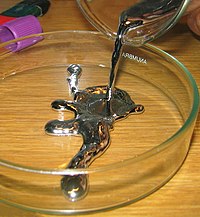
Photo from wikipedia
Mineralogy and gold processing techniques from several mining areas of the Nazca-Ocoña gold belt, Mid-South Peru, were investigated to assess the efficiency of gold extraction methods in relation to their… Click to show full abstract
Mineralogy and gold processing techniques from several mining areas of the Nazca-Ocoña gold belt, Mid-South Peru, were investigated to assess the efficiency of gold extraction methods in relation to their mineralogy. The deposits from this belt are intrusion gold related to mineralization in quartz veins. Native gold occurs as micrometric grains encapsulated in pyrite and in minor amounts in other sulfides and quartz. Electrum is found mainly in fractures of pyrite and attains up to 35 wt. % Ag. In addition to these occurrences, gold tellurides also occur and they are abundant in San Luis. Gold processing is carried out by amalgamation with mercury and/or cyanidation. The comparison of the gold grade in the mineralizations and in the residual tailings indicates that a significant amount of gold is not recovered using the mercury amalgamation process and also, in the case of the gold recovery by cyanidation, except when cement was added to the cyanide solution. This was due to an increase in the pH that favours the dissolution of the gold matrix. In the cyanidation process carried out in tailings previously treated with mercury, part of the mercury retained in them is released to the atmosphere or to the cyanidation fluids.
Journal Title: Minerals
Year Published: 2019
Link to full text (if available)
Share on Social Media: Sign Up to like & get
recommendations!